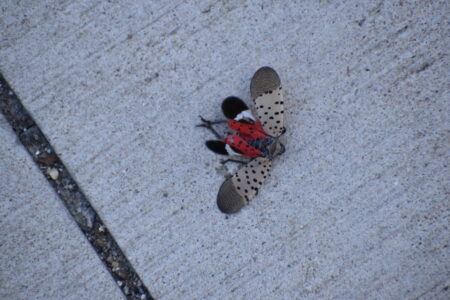Invasion of the Spotted Lanternflies: Local Pest Population Increases Dramatically

photo by: Eric Ayres
The spotted lanternfly has become much more prevalent in the Ohio Valley this year.
WHEELING — Ohio Valley residents’ eyes aren’t deceiving them. They’re seeing more spotted lanternflies than ever before. The invasive insect with the distinct markings are being found throughout the region — and that’s bad news for plenty of its plant life.
The spotted lanternfly, native to Vietnam, India and China, was found in Berks County, Pennsylvania, in 2014 and started spreading outward. It was first seen in West Virginia in 2019 in Berkeley County in the Eastern Panhandle. The insect, known for its gray, spotted wings and red body, then headed west, embedding in north central West Virginia and the Northern Panhandle, as well as eastern Ohio.
According to the West Virginia Department of Agriculture, the spotted lanternfly can be found in Hancock, Brooke, Ohio and Marshall counties.
According to the Ohio Department of Agriculture, the insect was confirmed and established in Belmont and Jefferson counties, while being reported but not confirmed in Harrison and Monroe counties.
Julianne Latynski, an urban ecosystem manager in Ohio County, said the insect’s abundance in the area is twofold. As the lanternfly season draws to a close, it is seen more often. But there also are more of them overall.
“We were counting very, very few in the summer of 2023,” she said. “Since then, the populations have quadrupled and they’re everywhere.”
The lanternfly’s favorite meal is the tree-of-heaven, itself an invasive plant, but that’s not the only food on the menu. Latynski said the bug feeds on many other fruit trees and vines, like grape, apple, cherry, peach, maple and walnut.
In feeding on the sap of those plants, the lanternfly can secrete a sticky liquid called honeydew, which can breed a black, sooty mold that can kill the leaves of the trees by blocking the sunlight from reaching them. Latynski said the insects also can introduce foreign fungi and bacteria into the tree, as well as open “a bunch of little wounds” on the tree, which could also damage them.
“That’s damaging to both the viticultural and horticultural industries, which is our main concern with these pests,” she said.
If you see a lanternfly, Latynski said, you should destroy it. Squashing it with your shoe works, but lanternflies are quick, and can hop away before your foot comes down.
“My big tip is, if you sneak up on them from the front, they can only jump forward,” she said, “so even if they jump, they’re going to jump into your foot.”
Another method is a mix of 90% water and 10% dish soap, Latynski said. Those who want to use the spray shouldn’t do so during peak sun hours, as spraying the concoction on the leaves could burn them.
Otherwise, the best method is to destroy the lanternflies’ egg masses, which Latynski said look like little smears of mud. The flies lay those eggs in the fall, the eggs grow through the winter and hatch in the spring, and each egg mass holds a large amount of eggs.
“So by scraping off and smooshing those egg masses, you can drastically reduce the population within a small area,” she said. “(The lantern flies) don’t live to see the next season, but their children do.”




